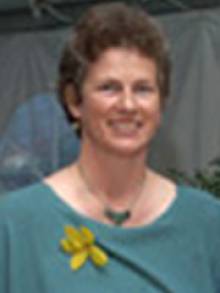Susan Lacerte
MPA in Public & Nonprofit Management & Policy
-
1991

There’s something about the number 13 this year for Susan Lacerte (MPA ’91). She has been at the Queens Botanical Garden for 13 years, and as a leap-year baby, she will be celebrating her 13th actual birthday on February 29th. But superstitious or not, nothing seems unlucky about her current circumstances. As Executive Director of the Garden, she leads one of New York City’s most beautiful institutions.
Lacerte knew at age 14 that she wanted to work with plants. Raised by a mother who often took her camping and a father who always had a vegetable garden, her interest was piqued when she saw naturalist Euell Gibbons on television. After studying forestry at Penn State and environmental horticulture at the University of Connecticut – where she realized her heart was in public horticulture – Lacerte took a position in the education department at the Wildcliff Museum in New Rochelle. She did an internship at the Queens Botanical Garden and then worked at the Brooklyn Botanic Garden in adult education. While she enjoyed her work there, she explains she “wanted to be in a bigger world,” and that’s when she decided to enroll at NYU. While studying for her MPA, Lacerte says, her “mind popped open,” as she was coming from a science background and moving into a more liberal arts arena.
While she was in school, Lacerte did an internship at the Brooklyn Economic Development Corporation and was also the first intern for the City Council Finance Division after charter change. After graduating, she worked for three years at the City Council and then in 1994, a new board at the Queens Botanical Garden brought her on as the organization’s executive director. At first, she says, there was a feeling of being overwhelmed, as her new job required her to circulate in many spheres. She relied on her experience from her internships and was glad to understand processes such as budgeting and financial planning. She also appreciated coming from Wagner and understanding how to frame issues and understand them, how to recognize what groups have interest in them and how to formulate solutions even with unknowns and uncertainties.
Early in her tenure, Lacerte led the organization in both strategic planning and budget planning. Recognizing that their botanical garden was located in the most ethnically diverse county in the nation, the board adopted a cultural vision and devised a goal to become the place “where people, plants and cultures meet.” Staff created cultural advisory committees to help them understand how people from different backgrounds relate to plants and what plants are most important in various cultures. The Garden is a place where “diverse groups of people come together to interact with nature and each other.”
Lacerte led the staff and board in another round of strategic planning, which resulted in the adoption a mission of environmental sustainability. The organization has been at the leading edge of the city’s green movement, and one that is in fact sweeping the entire nation. In 2007 the Garden opened a Visitor and Administration building designed to attain the highest ‘Leadership in Energy and Environmental Design’ (LEED®) rating. At the same time it also completed several new sustainable landscapes. The new building has three “working” roofs, one that changes the sun’s energy into electricity through photovoltaic panels, another that captures water for reuse and a third is an accessible—and beautiful—planted, or green roof.
After thirteen years at her post, Lacerte still faces resource challenges prevalent at any nonprofit, but she loves her job and loves that she “gets to do it all.” She recalls that she used to do a lot of different things herself at the organization, but now much of her job is communication, both internal and external, and “getting people in the right place” to get things done. Lacerte believes botanical gardens offer an essential service to the public. There is a role for gardens, she says, “to highlight our natural resources,” helping us understand how we depend on plants for food, fabric, building materials and more. Furthermore, at least in New York, they offer a welcome refuge from a noisy, crowded, concrete jungle. As the Village Voice New York City Guide states, “count yourself lucky if you live near this Flushing haven.” Surely Lacerte does just that.